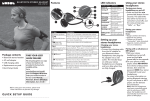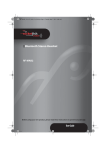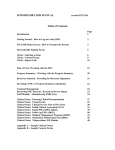Download Modal MD-HPBT01 Specifications
Transcript
MD-HPBT01_14-0244_MAN_V1_ENG.fm Page 1 Tuesday, July 8, 2014 10:25 AM MD-HPBT01 Bluetooth Stereo Headset Before using your new product, please read these instructions to prevent any damage. MD-HPBT01_14-0244_MAN_V1_ENG.fm Page 2 Tuesday, July 8, 2014 10:25 AM Modal MD-HPBT01 Bluetooth Stereo Headset Contents Introduction ...................................................................... 2 Features............................................................................... 3 Setting up your stereo headphones......................... 6 Using your stereo headphones .................................. 6 Maintaining .....................................................................15 Troubleshooting ............................................................15 Specifications..................................................................18 Legal notices ...................................................................19 One-Year Limited Warranty........................................21 Introduction Congratulations on your purchase of a high-quality Modal product. Your MD-HPBT01 represents the state of the art in Bluetooth stereo headset design and is designed for reliable and trouble-free performance. 2 MD-HPBT01_14-0244_MAN_V1_ENG.fm Page 3 Tuesday, July 8, 2014 10:25 AM Features Package contents • • • • • Bluetooth stereo headset AC wall adapter USB charging cable Replacement ear pads Quick Setup Guide MD-HPBT01 3 MD-HPBT01_14-0244_MAN_V1_ENG.fm Page 4 Tuesday, July 8, 2014 10:25 AM Side view # Item Logo with indicator LED 2 Volume Up/Down 1 Description Indicator LED show current status of the headphones. See the LED Indicators table on page 5. Press + or – to increase or decrease the volume. 3 (power/talk) button Press to turn on your stereo headphones. If you receive a phone call, press to talk. Press to turn off your stereo headphones. 4 (play/pause) button Press to begin playback. During playback, press to pause playback. Press again to resume playback. the micro USB connector from the AC adapter into this port 5 Micro USB connector Plug to charge your headphones. 7 Microphone • Press once to return to the beginning of a track. • Press twice to go to the previous track. • Press and hold to rewind. • Press once to skip to the next track. • Press and hold to fast-forward. Allows you to talk on the telephone. 8 Reflective strip An attractive feature and provides extra safety in low-light conditions. (rewind) 6 (fast forward) 4 MD-HPBT01_14-0244_MAN_V1_ENG.fm Page 5 Tuesday, July 8, 2014 10:25 AM LED indicators Headphones status LED status Power on Blue LED flashes Turning off Red LED dims and disappears Low battery Red LED blinks continuously Recharging Red LED stays on Recharging complete Blue LED stays on Pairing mode Blue and red LEDs flash rapidly Connection complete Blue LED blinks every five seconds Receiving a call Blue LED flashes rapidly Talking on the phone Blue LED brightens and dims repeatedly MD-HPBT01 5 MD-HPBT01_14-0244_MAN_V1_ENG.fm Page 6 Tuesday, July 8, 2014 10:25 AM Setting up your stereo headphones Charging your stereo headphones When your stereo headphone’s battery is low, the red LED blinks. To charge your stereo headphones: • Connect the charging cable from the AC adapter to your Bluetooth stereo headphones and plug the AC adapter into a wall outlet. The red LED stays on while your stereo headphones are charging and turns blue when they are fully charged. Using your stereo headphones Turning your stereo headphones on and off To turn your stereo headphones on and off: • Press and hold the (power/talk) button for two seconds. The LED blinks blue (when turned on) or red (when turned off ), and the voice prompt says “Hello”, or “Bye.” 6 MD-HPBT01_14-0244_MAN_V1_ENG.fm Page 7 Tuesday, July 8, 2014 10:25 AM Pairing your stereo headphones with a Bluetooth device Your stereo headphones can store pairing information for up to 8 Bluetooth devices, such as phones and tablets. Notes: Your stereo headphones: - Range is 33 feet (10 meters). - Support easy pairing. - Prompt you by saying “Connected,” when connected. - Support a battery indicator icon on an iOS device. 1 Make sure that your Bluetooth device supports the Bluetooth V 3.0 2 3 4 5 protocol and is not paired with another device. To determine what Bluetooth protocol your device supports, see the documentation that came with your device. With the headphones turned off, press and hold (power/talk) for four seconds. The LED blinks blue and red rapidly, then pairing mode is activated. Make sure that your Bluetooth device is within 33 feet of your stereo headphones. Turn on your Bluetooth device, turn on Bluetooth, then set your device to pairing mode. For more information, see the documentation that came with your Bluetooth device. On your Bluetooth device, select “MD-HPBT01”, then enter the password 0000 (four zeros), if required, to pair your headphones. Your stereo headphones pair with the Bluetooth device and the LED on your stereo headphones blinks blue every two seconds. For more information on pairing Bluetooth devices to your cell phone or MP3 player, see the device's documentation. MD-HPBT01 7 MD-HPBT01_14-0244_MAN_V1_ENG.fm Page 8 Tuesday, July 8, 2014 10:25 AM Reconnecting to a paired device When your stereo headphones are not paired to a device, the Blue and red LEDs flash rapidly. • After the headphones have been successfully paired with the cell phone or MP3 player, the headphones will automatically reconnect to the phone or MP3 player. If a device does not automatically reconnect, you may need to reselect MD-HPBT01 on your Bluetooth device. Your stereo headphones will lose the Bluetooth connection if you: Turn them off. To reconnect: Turn on your stereo headphones. Your stereo headphones search for the last connected Bluetooth device and reconnect automatically. Move the Bluetooth device out of range. Make sure that your Bluetooth device is within 33 feet of your stereo headphones. Turn off the Bluetooth device. Turn on the Bluetooth device, then make sure that Bluetooth is turned on. Turn off Bluetooth on your Bluetooth Turn on Bluetooth on your Bluetooth device. device. Connect your Bluetooth device to Disconnect your Bluetooth device from the other another Bluetooth device. device, then set your device to pairing mode. Select MD-HPBT01 on the Bluetooth device. Pairing with a computer running Windows Note: Before you pair the headphones with the computer, make sure that the computer is equipped with Bluetooth. Refer to the computer's documentation or contact the computer manufacturer for more information. If your computer is not Bluetooth compatible, install a Bluetooth USB adapter (dongle). 1 Turn on Bluetooth on the computer. For instructions, see the computer's documentation or contact the computer manufacturer. 2 Double-click the Bluetooth icon in the system tray, then click Add a device (Add Wireless Device using Windows Vista). -ORIf you’re using Windows XP, click Add a New Bluetooth Device. When the Add Bluetooth Device Wizard opens, click Next. 3 With the headphones turned off, press and hold (power/talk) for four seconds. The LED blinks blue and red rapidly, then pairing mode is activated. 8 MD-HPBT01_14-0244_MAN_V1_ENG.fm Page 9 Tuesday, July 8, 2014 10:25 AM 4 Double-click the MD-HPBT01 icon on the computer or highlight the icon and click Next. Note: If you are unable to locate the MD-HPBT01 icon, click the Search Again button. 5 If required, enter 0000 (four zeros) in the Bluetooth security code field, then click Next. 6 After the headphones have been paired, click Close. If you are using Windows XP, continue with steps 7 through 9. 7 Select one of the Bluetooth hands-free types shown on the Add a Bluetooth Device Wizard screen, then click Next. 8 Select the services shown on the wizard screen to use with your Bluetooth headphones, then click Finish. 9 To connect the device, double-click the MD-HPBT01 Hands-Free Unit icon or the MD-HPBT01 Stereo Audio icon. Note: The headphones should be automatically selected as the default playback device (Windows Vista, Windows 7, or Windows 8), or the default recording and playback device (Windows XP). To make those settings manually, see the following sections. Setting the headphones as the default playback device using Windows Vista, Windows 7, or Windows 8 1 Click Start, then click Control Panel. 2 Click Hardware and Sound, then under Sound, click Manage audio devices. 3 On the Recording tab, select Headset Microphone Bluetooth Hands-free Audio, then click Set Default. 4 On the Playback tab, select Speakers Bluetooth Hands-free Audio, then click Set Default. 5 Click OK to finish. Setting the headphones as the default recording and playback device using Windows XP 1 Click Start, then click Control Panel. 2 Click Sounds, Speech, and Audio Devices, then click the Sounds and Audio Devices icon. 3 On the Audio tab, select Bluetooth Hands-free Audio or Bluetooth Stereo Audio in the Sound recording list, then select Bluetooth Hands-free Audio in the Sound playback list, if it is an option. MD-HPBT01 9 MD-HPBT01_14-0244_MAN_V1_ENG.fm Page 10 Tuesday, July 8, 2014 10:25 AM Pairing with a Mac computer Note: Before you pair the headphones with the computer, make sure that the computer is Bluetooth compatible. Refer to the computer's documentation or contact the computer manufacturer for more information. If your computer is not Bluetooth compatible, install a Bluetooth USB adapter (dongle). 1 Turn on Bluetooth on the computer. For instructions, see the computer's 2 3 4 5 6 7 8 9 10 documentation or contact the computer manufacturer. Click the Bluetooth status menu. Click Set up Bluetooth Device. The Bluetooth Setup Assistant opens. Click Continue. Select Headset as the device type, then click Continue. With the headphones turned off, press and hold (power/talk) for four seconds. The LED blinks blue and red rapidly, then pairing mode is activated. Select MD-HPBT01, then click Continue. The computer gathers information. Click Continue. Enter 0000 (four zeros) into the Passkey field, then click Continue. Click Quit to finish. Note: To use the headphones, they must be selected as the default input and output device on the computer. 11 Click System Preferences, then click Sound. 12 Under Input, select MD-HPBT01, then under Output, select MD-HPBT01. Using your stereo headphones with Skype Note: Before you pair the headphones with the computer, make sure that the computer is Bluetooth compatible. Refer to the computer's documentation or contact the computer manufacturer for more information. If your computer is not Bluetooth compatible, install a Bluetooth USB adapter (dongle). 1 Turn on your Bluetooth headphones, then right-click the Bluetooth icon at the bottom left- hand side of your computer screen. The Bluetooth icon appears there. Right-click the icon and click Add Device. 2 Find your Bluetooth headphones on the list and double-click it. The computer and Bluetooth headphones will now sync. 3 Open the Skype program. On the top menu bar, click the Tools tab, then click Options. 10 MD-HPBT01_14-0244_MAN_V1_ENG.fm Page 11 Tuesday, July 8, 2014 10:25 AM 4 Select Sound Devices, then Bluetooth Audio for both audio in and audio out. 5 Enter the Skype username as “echo123” to verify that your audio settings are correct. The “echo123” username is Skype's sound test service that can help you make sure your Bluetooth works with Skype. Using 3D Sound To enable 3D sound while listening to music, press and hold the (play/pause) button to select the next pre-set 3D sound effect. Normal mode and four types of 3D sound effects are programmed in the order below. • Normal – It makes playback of the original sound of music source. (Two beeps indicate Normal mode.) • XOME – Provides comfortable and persistent listening environment by taking distractible sound away from ears and head when using earphones. • Live – Delivers a natural and soft 3D sound field effect simulating that of a live performance. • Wide – Provides a panoramic 3D audio image of widely spread main vocal and center-placed instruments. • MEX – Not only delivers wide stereo sound image, but also enhances low-frequency sound to provide rich and deep bass tones. Playing music To: Do this: (play/pause) Stop Select a song Fast forward or rewind a song Answer a call while playing music Change the volume Press (play/pause) to launch the phone's MP3 player and begin playing music. Press this button to pause and resume playback. Double-click (play/pause) to stop playback. Press and release or . While the music is playing, press and hold or . (Some phones may not support this feature.) Press (power/talk) to accept the call, or press (play/pause) to reject the call. Press (power/talk) again to end the call. The music resumes playing after a call is rejected or ended. Press + or - . MD-HPBT01 11 MD-HPBT01_14-0244_MAN_V1_ENG.fm Page 12 Tuesday, July 8, 2014 10:25 AM Making a Phone Call To: Do this: Voice dial Press (power/talk) once. (Some phones might not support this feature.) Press (power/talk) twice. Press (power/talk) once. Press (power/talk) once. Redial Answer a call End a call Refuse a call Change the volume Transfer a call between connected devices While your phone is ringing, press Press + or - . Press (power/talk) twice. (play/pause). Multi Pairing Before you can connect the headphones to two devices, you must pair to each device individually. The device you are pairing must support one of the following Bluetooth profiles: • A2DP (Advanced Audio Distribution Profile)–Provides high quality Audio (stereo and mono) communication between the headphones and a phone's or computer's MP3 player. • AVRCP (Audio Video Remote Control Profile)–Lets an MP3 player control the headphones media playback buttons (such as (play/pause) or rewind/fast-forward). If you connect an MP3 player, the player must support AVRCP. See the documentation that came with the MP3 player to determine if the player supports AVRCP. Windows Media Player supports AVRCP. • HSP (Headset Profile)–Provides two-way communication between the headphones and a Bluetooth phone. This profile is the most commonly used profile for Bluetooth phones. A paired phone must support HSP or HFP. See the documentation that came with the phone to determine if the phone supports HSP or HFP. • HFP (Hands-Free Profile)–Provides two-way communication between the headphones and a Bluetooth phone. If the phone does not use HSP, it uses this profile. A paired phone must support HSP or HFP. See the documentation that came with the phone to determine if the phone supports HFP or HSP. 12 MD-HPBT01_14-0244_MAN_V1_ENG.fm Page 13 Tuesday, July 8, 2014 10:25 AM Notes: A profile can only connect one device at a time. For example, you cannot use a phone's MP3 player and a computer's MP3 player at the same time, because both players are connected through the A2DP profile. You can connect a phone and a computer at the same time because the phone uses HSP or HFP and the computer uses A2DP. This lets you listen to music from the computer and answer phone calls at the same time. In multi-pairing mode, some functions may be restricted depending on the host devices. Not all devices and functions may be compatible with multi-pairing. Resetting the MD-HPBT01 In case the MD-HPBT01 needs to be reset, press Play, Talk, and + (volume up) simultaneously. Replacing the ear pads 1 Rotate the ear pads counterclockwise, the remove them. 2 Replace the ear pads by placing them on the headset, then rotating them clockwise. MD-HPBT01 13 MD-HPBT01_14-0244_MAN_V1_ENG.fm Page 14 Tuesday, July 8, 2014 10:25 AM Each ear pad is labeled with an L (for left) or an R (for right), along with an arrow. To correctly replace the ear pad, this arrow should be pointed towards the back of the headset (i.e., the headband). ; 2 Note: For additional help, see the online instructional video at www.bestbuy.com/modal under Modal Resources. 14 MD-HPBT01_14-0244_MAN_V1_ENG.fm Page 15 Tuesday, July 8, 2014 10:25 AM Maintaining • Do not place the headphones near a fire. The battery may explode. • Do not drop or apply excessive force to the headphones. You may damage them. • When storing the headphones for an extended period of time, store them in a dry place and avoid extreme temperatures. • If the headphones get wet, avoid exposure to heat or an electrical current. Contact a service center or the store where you purchased the headphones. • Do not use any charging device except the device that came with the headphones. Troubleshooting No power. The battery does not stay charged. The headphones are not working at all (does not turn on using the (power/talk) button, no indicator lights turn on.) I do not get as much talk time as I used to. I cannot replace the battery. The USB charging cable was damaged. • Make sure that the AC adapter power cord is connected to your stereo headphones. • Make sure that your stereo headphones are turned on. • Charge the headphones for at least three hours the first time they are charged. • Allow the battery to fully charge each time you charge it. • The indicator light turns solid red when recharging. • The battery is fully charged when the LED changes from red to blue. • The headphones turn off when the battery charge is low. Make sure that the headphones are fully charged. • Allow the battery to fully charge each time you charge it. • The indicator light turns solid red when recharging. • The battery is fully charged when the LED changes from red to blue. • Try power cycling the headphones by unplugging them and plugging them back in. • Try charging the headphones using a different outlet. • The battery life diminishes over time. • Battery life is also dependent on conditions of use. • The rechargeable battery is not a customer replaceable part. • New USB charging cables are not available for purchase. MD-HPBT01 15 MD-HPBT01_14-0244_MAN_V1_ENG.fm Page 16 Tuesday, July 8, 2014 10:25 AM No sound, or low sound, comes from the headphones. I cannot pair the headphones with other devices. My Bluetooth device keeps unpairing. MD-HPBT01 does not appear on my Bluetooth device selection list. 16 • The battery may be dead. Recharge the battery. • Make sure that your Bluetooth device is turned on, that Bluetooth mode is turned on, and that your stereo headphones are selected. • Make sure that the audio source (for example, a computer, MP3 player, or phone) is turned on. • Make sure that the headphones’ volume and the audio source's volume are turned up. • Make sure that your stereo headphones are in pairing mode. • If the headphones are paired to a computer, make sure that the headphones are selected as the playback default and recording device. For instructions, see one of the following: • “Pairing with a computer running Windows“ on page 8. • “Pairing with a Mac computer“ on page 10. • Try re-pairing the headphones. See “Pairing your stereo headphones with a Bluetooth device“ on page 7. • You may need to turn off the paired audio source's internal speakers before the audio source can send audio to the headphones. See the documentation for the audio source. • Make sure that the sound is not muted on the paired audio source. • Make sure that your stereo headphones are not paired to another Bluetooth device. • Make sure that your Bluetooth device is not paired to a device other than your stereo headphones. • Shorten the distance between your stereo headphones and the Bluetooth device. • Turn off the Bluetooth device, then back on again. Re-pair your stereo headphones with the Bluetooth device. • Make sure that your stereo headphones are not paired to another Bluetooth device. • Make sure that your Bluetooth device is not paired to a device other than your stereo headphones. • Make sure that your stereo headphones and the Bluetooth device have Bluetooth turned on and are in pairing mode. • Make sure that your stereo headphones are selected on the Bluetooth device. • The headphones only work with devices that support the HSP, HFP, or A2DP profile. You cannot pair the headphones with devices such as a regular cordless phone. • Shorten the distance between your stereo headphones and the Bluetooth device. • The battery on your stereo headphones or your Bluetooth device may be dead. Recharge the battery. • Shorten the distance between your stereo headphones and the Bluetooth device. • Put your stereo headphones into pairing mode, then refresh your list of Bluetooth devices. For more information, see the documentation that came with your Bluetooth device. MD-HPBT01_14-0244_MAN_V1_ENG.fm Page 17 Tuesday, July 8, 2014 10:25 AM The sound has static or breaks up. The headphones do not control the volume. The headphones volume is low. The headphones make a long, low tone every 30 seconds. The headphones are connected to a computer, but sound is coming from the computer instead of the headphones. • If the distance between the headphones and the audio source is greater than the maximum distance (approximately 33 ft. [10 m]), reduce the distance between the headphones and the audio source. • If there are obstructions between the headphones and the audio source, move the headphones or the audio source away from the obstructions. • Other devices, such as cordless phones, microwaves, or wireless routers, may cause interference. • Try turning one device off at a time to determine which device is causing the interference. • If your cordless phone or wireless router is causing interference, try changing the channel the phone or router is using. For instructions, see the documentation that came with the phone or router. • If the headphones are paired to a computer, make sure that the headphones are selected as the playback default. For instructions, see one of the following: • “Pairing with a computer running Windows“ on page 8. • “Pairing with a Mac computer“ on page 10. • Make sure that the volume on your audio source (a computer, MP3 player, or phone) is turned up to at least 50% of its volume level. • Your headphones’ batteries may be dead. Try recharging your headphones. • Volume can decrease as the battery loses its charge. The battery life diminishes over time. Battery life is also dependent on conditions of use. • The battery is low. Recharge your headphones. • Make sure that the headphones are paired with the computer and that the settings are correct. For instructions, see one of the following: • “Pairing with a computer running Windows“ on page 8. • “Pairing with a Mac computer“ on page 10. MD-HPBT01 17 MD-HPBT01_14-0244_MAN_V1_ENG.fm Page 18 Tuesday, July 8, 2014 10:25 AM The headphones’ buttons do not control the audio device. The headphones’ microphone is not working. • In multi-pairing mode, some functions may be restricted depending on the devices paired to the headphones. • If you pair both a phone and an MP3 player, the device you pair last has priority. For example, if you pair a phone, then pair an MP3 player, the MP3 player controls the buttons on the headphones. You can answer the phone while listening to music, but you cannot use the phone's redial or voice recognition functions. • After the device with priority is shut off or unpaired, you may have to re-pair the second device for the headphones’ buttons to regain control. • Make sure that the headphones are paired with the computer and that the settings are correct. For instructions, see one of the following: • “Pairing with a computer running Windows“ on page 8. • “Pairing with a Mac computer“ on page 10. Specifications Bluetooth version Supported profiles Supported Codec Frequency spectrum Working distance Operating temperature Operating time Standby time Dimensions Weight Average charging time V 3.0 A2DP, AVRCP, HFP, HSP SBC 2.4 ~ 2.4835 GHz ISM Band Up to 33 ft. (10 m) 14~140 degrees F (-10 ~ +60 degrees C) Talk - 14 hours / Music - 12 hours 340 hours 5.3 x 4.4 x 2.2 in. (13.5 x 11.2 x 5.6 cm) 2.1 oz. (59.8 g) 3.5 hours Note: Hours of battery use vary depending on volume level and audio content. These specifications are subject to change with the product version. 18 MD-HPBT01_14-0244_MAN_V1_ENG.fm Page 19 Tuesday, July 8, 2014 10:25 AM Legal notices FCC Statement This device complies with Part 15 of the FCC Rules and Industry Canada licence-exempt RSS standard(s). Operation is subject to the following two conditions: (1) this device may not cause harmful interference, and (2) this device must accept any interference received, including interference that may cause undesired operation. This equipment has been tested and found to comply with the limits for a Class B digital device, pursuant to Part 15 of the FCC Rules. These limits are designed to provide reasonable protection against harmful interference in a residential installation. This equipment generates, uses and can radiate radio frequency energy and, if not installed and used in accordance with the instructions, may cause harmful interference to radio communications. However, there is no guarantee that interference will not occur in a particular installation. If this equipment does cause harmful interference to radio or television reception, which can be determined by turning the equipment off and on, the user is encouraged to try to correct the interference by one or more of the following measures: • Reorient or relocate the receiving antenna. • Increase the separation between the equipment and receiver. • Connect the equipment into an outlet on a circuit different from that to which the receiver is connected. • Consult the dealer or an experienced radio/TV technician for help. Warning: Changes or modifications not expressly approved by the party responsible for compliance could void the user's authority to operate the equipment. Interference Notice Bluetooth products are a radio device that might cause interference with other non-Bluetooth devices (for instance, devices using wireless LAN). 802.11b technology might cause degradation on the performance of Bluetooth devices. Caution: • • To comply with FCC RF exposure compliance requirements, a separation distance of at least 20 cm must be maintained between the antenna of this device and all persons. This Transmitter must not be co-located or operating in conjunction with any other antenna or transmitter. MD-HPBT01 19 MD-HPBT01_14-0244_MAN_V1_ENG.fm Page 20 Tuesday, July 8, 2014 10:25 AM Department of Communications-Canada Canadian Compliance Statement This equipment complies with IC radiation exposure limits set forth for an uncontrolled environment. Le présent appareil est conforme aux CNR d'Industrie Canada applicables aux appareils radio exempts de licence. L'exploitation est autorisée aux deux conditions suivantes : (1) l'appareil ne doit pas produire de brouillage, et (2) l'utilisateur de l'appareil doit accepter tout brouillage radioélectrique subi, même si le brouillage est susceptible d'en compromettre le fonctionnement. Cet équipement est conforme à l'exposition aux rayonnements Industry Canada limites établies pour un environnement non contrôlé." 20 MD-HPBT01_14-0244_MAN_V1_ENG.fm Page 21 Tuesday, July 8, 2014 10:25 AM One-Year Limited Warranty Modal Products (“Modal”) warrants to you, the original purchaser of this new MD-HPBT01 (“Product”), that the Product shall be free of defects in the original manufacture of the material or workmanship for one (1) year from the purchase of the Product (“Warranty Period”). This Product must be purchased from an authorized dealer of Modal brand products and packaged with this warranty statement. This warranty does not cover refurbished Product. If you notify Modal during the Warranty Period of a defect covered by this warranty that requires service, terms of this warranty apply. How long does the coverage last? The Warranty Period lasts for one year (365 days), beginning on the date you purchased the Product. The purchase date is printed on the receipt you received with the product. What does this warranty cover? During the Warranty Period, if the original manufacture of the material or workmanship of the Product is determined to be defective by an authorized Modal repair center or store personnel, Modal will (at its sole option): (1) repair the Product with new or rebuilt parts; or (2) replace the Product at no charge with new or rebuilt comparable products or parts. Products and parts replaced under this warranty become the property of Modal and are not returned to you. If service of Products and parts are required after the Warranty Period expires, you must pay all labor and parts charges. This warranty lasts as long as you own your Modal Product during the Warranty Period. Warranty coverage terminates if you sell or otherwise transfer the Product. How to obtain warranty service? If you purchased the Product at a retail store location, take your original receipt and the Product to the store you purchased it from. Make sure that you place the Product in its original packaging or packaging that provides the same amount of protection as the original packaging. If you purchased the Product from an online web site, mail your original receipt and the Product to the address listed on the web site. Make sure that you put the Product in its original packaging or packaging that provides the same amount of protection as the original packaging. Where is the warranty valid? This warranty is valid only to the original purchaser of the Product in the United States, Canada, and Mexico. What does the warranty not cover? This warranty does not cover: • Customer instruction • Installation • Set up adjustments • Cosmetic damage • Damage due to acts of God, such as lightning strikes MD-HPBT01 21 MD-HPBT01_14-0244_MAN_V1_ENG.fm Page 22 Tuesday, July 8, 2014 10:25 AM • Accident • Misuse • Abuse • Negligence • Commercial use • Modification of any part of the Product, including the antenna This warranty also does not cover: • Damage due to incorrect operation or maintenance • Connection to an incorrect voltage supply • Attempted repair by anyone other than a facility authorized by Modal to service the Product • Products sold as is or with all faults • Consumables, such as fuses or batteries • Products where the factory applied serial number has been altered or removed REPAIR REPLACEMENT AS PROVIDED UNDER THIS WARRANTY IS YOUR EXCLUSIVE REMEDY. MODAL SHALL NOT BE LIABLE FOR ANY INCIDENTAL OR CONSEQUENTIAL DAMAGES FOR THE BREACH OF ANY EXPRESS OR IMPLIED WARRANTY ON THIS PRODUCT, INCLUDING, BUT NOT LIMITED TO, LOST DATA, LOSS OF USE OF YOUR PRODUCT, LOST BUSINESS OR LOST PROFITS. MODAL PRODUCTS MAKES NO OTHER EXPRESS WARRANTIES WITH RESPECT TO THE PRODUCT, ALL EXPRESS AND IMPLIED WARRANTIES FOR THE PRODUCT, INCLUDING, BUT NOT LIMITED TO, ANY IMPLIED WARRANTIES OF AND CONDITIONS OF MERCHANTABILITY AND FITNESS FOR A PARTICULAR PURPOSE, ARE LIMITED IN DURATION TO THE WARRANTY PERIOD SET FORTH ABOVE AND NO WARRANTIES, WHETHER EXPRESS OR IMPLIED, WILL APPLY AFTER THE WARRANTY PERIOD. SOME STATES, PROVINCES AND JURISDICTIONS DO NOT ALLOW LIMITATIONS ON HOW LONG AN IMPLIED WARRANTY LASTS, SO THE ABOVE LIMITATION MAY NOT APPLY TO YOU. THIS WARRANTY GIVES YOU SPECIFIC LEGAL RIGHTS, AND YOU MAY ALSO HAVE OTHER RIGHTS, WHICH VARY FROM STATE TO STATE OR PROVINCE TO PROVINCE. Contact Modal: For customer support, call 1-800-499-3402 (U.S. and Canada) www.bestbuy.com/modal Distributed by Best Buy Purchasing, LLC 7601 Penn Avenue South, Richfield, Minnesota, U.S.A. 55423-3645 © 2014 Best Buy Enterprise Services, Inc. All rights reserved. MODAL is a trademark of Best Buy Enterprise Services, Inc. Registered in some countries. All other products and brand names are trademarks of their respective owners. Made in Korea. 22 MD-HPBT01_14-0244_MAN_V1_ENG.fm Page 23 Tuesday, July 8, 2014 10:25 AM MODAL is a trademark of Best Buy and its affiliated companies. Registered in some countries. Distributed by Bust Buy Purchasing, 7601 Penn Ave South, Richfield, Mn 55423 U.S.A. © 2014 Best Buy. All rights reserved. Made in Korea. V1 ENGLISH 14-0244
































